Tags

It’s time for you to go one on one with Thailand’s iconic symbol: the elephant (and you thought that butt was the photo’s focal point).
What’s the first thing to come to mind when you think about Thailand? Okay, make that the second thing. There’s a good chance your answer would (then) be elephants. An iconic symbol of the country, elephants are much loved by the Thai people, and for many touri one of the more memorable experiences of their visit to Thailand. At least if they get out of Bangkok. Riding an elephant is one of the Must Do touri experiences in the Land of Smiles, but you really need to head up north for that treat. And it is an awesome thing to do. For about 5 minutes.
In Bangkok you are not as likely to stumble upon the opportunity of taking an elephant for a spin (though bar boys get that joy almost nightly). In Bangkok your elephant experience is more likely to be stumbling upon one with its trainer on the streets where you’ll get to overpay for some treats to feed the pachyderm. Who, as a thanks, will let loose with a gushing stream of urine guaranteed to splatter anyone within half a block. Come to think of it, that too could be one of your more memorable Bangkok experiences.
With Thailand and elephants being so interlinked, not including some sort of elephant-related activity as part of your Thailand holiday just doesn’t cut it. And if your visit includes plans to head to Chiang Mai, as a first time visitors you really should visit one of the elephant camps. If, on the other hand, your plans are to stay in Bangkok, do yourself a favor and skip the one-day elephant camp tours offered to the tour bus crowds by enterprising locals. All are a long drive away from town, none offer much in the way of humane treatment of the animals. You’ll be much better off waiting to do it right and use it as an excuse to visit Thailand once again. But that doesn’t mean your Bangkok holiday has to be elephantless. In fact, it shouldn’t. Because a day’s travel experience devoted to elephant sightings is the on my list of the Top Ten Bangkok Experiences. And wild animal urine plays no part in today’s activities. Almost.
To avoid the major part of your Bangkok experience being hours communing with the city’s notorious traffic gridlock, I usually suggest a day full of activities that are in close proximity to each other. But since the main experience in today’s suggestion is already much further afield than most touri go, I’m throwing traffic to the wind. No worries. You’ll still be spending more time communing with Thai tourist attractions than Thai parking lot like attractions. Unfortunately, for this one you are gonna have to get up early for a change. Damn elephants!
First up, after breakfast and enough caffeine to get you through the next few hours, a late afternoon option is offered too. But, as I will soon explain, you are better off pulling yourself out of bed early instead. Since part of what makes an elephant an elephant is the copious amounts of food they eat each day, that’s where we’ll start. ‘Cuz nothing says, “I just got back from a trip to Thailand” than you starting looking a lot like the country’s favorite mammal.
With branches in London, Paris, Jakarta, Dubai, and elsewhere around the globe, since 1980 the Blue Elephant Restaurant has offered an award winning menu of Royal Thai cuisine. And that doesn’t mean the stuff you’ll find at street carts. Royal Thai cuisine is what is served at official dinners at the palace. It’s fancy, but bland with the idea being you don’t want to serve something to visiting heads of state that will burn their taste buds. Or give them gas. So for most touri it is the perfect style of Thai cooking. Personally, I think there are better restaurants specializing in Royal Thai Cuisine in Bangkok. But the Blue Elephant’s saving grace is that it offers a cooking school too. And it’s about time you learned how to prepare a mal that doesn’t rely on nuking pre-made entrees in your microwave.
Classes are offered seven days a week, both in the morning and afternoon. Each class offers instruction in preparing four dishes, though those meals are different depending on the day you choose to attend. According to their website, the classes are good for novice and experienced cooks alike. So if you are of the former variety you classmates will all get a laugh out of your efforts. The cost, which is 2,800 baht, is the same for both the morning and afternoon class. But if you take the morning class it incudes a trip to a local wet market to pick up fresh ingredients.
Morning classes begin at 8:30 am and end a bit after 1pm when you sit down to enjoy the meal you’ve prepared. Fortunately, that meal also includes dishes prepared by the restaurant’s chefs; the afternoon session starts at 1:30 pm and dinner is served at 5pm. Included in the cost of the class are a certificate and a “delightful” Blue elephant apron.
If you are not a devotee of the Food Network, this might not seem like the best use of your limited time in Bangkok. But hey, you’ve probably been wrong many times before in your life too. The fact is it will be a memorable experience regardless of your abilities in the kitchen. And you will find yourself recreating the recipes when you get back home too.
The Blue Elephant Cooking School (and the restaurant too) is located at 233 South Sathorn Road. Booking your class at least one day in advance is recommended. You can do so, as well taking a look at each day’s class menu on their website: http://www.blueelephant.com/cooking-school/
So that’s one elephant down, and 3 and a tail’s end to go . . .
I’m not a museum kind of guy. At least not when it comes to the smaller provincial museums; there are usually better ways to commune with a country’s historical culture than what a local museum has to offer. So the idea of trekking out to a museum on the outskirts of town just never had much of an appeal to me. Even if it did feature a three-headed elephant. That just goes to show you that I too have been wrong in my life before. Your next stop in today’s Bangkok experience is the Erawan Museum, a place that would draw much larger crowds if it dropped ‘museum’ from its name. If museums don’t do it for you too, think incredible wat instead. And if you’ve had enough of Thai temples already, then think amusement park, or kitschy roadside attraction ‘cuz it qualifies as both of those too. And if none of those options work . . . I did mention the three-headed elephant, didn’t I?
There are several transpo option to get from the elephant you just finished with to the next one on today’s agenda. Those are listed in the fuller article about the Erawan below. But with your tummy full your best bet this time around is to grab a taxi (though you gotta admit it would be cool if you could ride an elephant to the museum). From Sathorn Road the fare will run you about 300 baht. And then you won’t have to deal with parking problems or grabbing a taxi from the closest BTS station either. Depending on traffic, which since it is still early enough in the afternoon shouldn’t be too bad, the ride will take you about half an hour. Unless your cabby gets lost.
Fair warning: This is one of those tourist attractions that charges a different entrance fee for farang. For Thais it is cheap enough you may want to spring for your taxi driver’s entrance and thereby avoid having to try to find a cab for the trip back into town. Either way, don’t whine about it. No one wants to hear your bitching and the 300 baht it cost to get in is well worth the price.
If you haven’t heard about the Erawan before, please read the fuller article linked to below. But neither that one nor this much more brief description really does the place justice. I’m a bit of a cynic (if you haven’t noticed) and am not easily impressed. The Erawan impressed me. In fact I would have listed it as my #1 Bangkok Experience, but for a first time visitor there are a few more significant places you really should see first. How Jim Thompson’s House makes everyone else’s Top Ten list when the Erawan doesn’t, though, is beyond me. I mean it’s not like you can’t find Thai silk neckties with little elephants on them at every night market in the Kingdom.
Finished in the early 2000s, the Erawan Museum is the brainchild of Lek Viriyaphant, a rich local boy with a profound love for both antiques and his religion. Somehow that turned into a structure with a 95 foot tall, 150 ton three-headed elephant on top that you can climb up through and grab a view over the surrounding rooftops out of the elephant’s ass. On the ground floor is the museum part which tells the story of how and why the building was erected. The lobby floor opens onto a colorful panorama filled with Buddhist and Hindu imagery in 3D topped by a domed stained glass window and featuring a grand staircase, which, when coming back down makes for a wonderful Hello Dolly moment.
At the very top is a shrine room filled with Buddhas and other religious-based statuary. This room holds the majority of Viriyaphant’s collection of ancient religious art. A large part of his purpose in building the museum was to provide a home for these images. Many are priceless objects of art; they were also held as sacred objects for people of ancient cultures. According to ancient traditions, they were believed to bring blessing and prosperity to the land and its people, and therefore must not be lost to outsiders. It was Viriyapant’s concern to find a way that would keep these objects safe that would also be suitable to their traditional functions. And thus the Erawan was born.
The Erawan is not a quick, rush through it and move on to the next site on your list kind of place. You need to take your time to really appreciate the place. Plan to spend a minimum of two hours; four is not too much. And make sure you take part in the various merit making activities the museum offers too. The grounds surrounding the main building are beautifully landscaped with secluded benches tucked into shady spots, perfect for taking in the tranquillity of the area and providing you with an opportunity to recharge your batteries. For more info and directions visit the Erawan’s website: http://www.erawan-museum.com/.
Knowing the state of mind that grand entrance you just made down the Erawan’s staircase put you in, we’ll continue in that vein and finish the day off with yet another splashy, regal entrance – and sneak in a bit of elephant splash while we’re at it. Make your way to the BTS and head for the Chao Phraya River at the Saphan Taksin Station. When you hit the river (well, don’t actually hit the river, stop just before you do) to the left of the express boat dock is a smaller concrete dock. This is where the shuttle ferry for the Peninsula Hotel boards passengers. The Peninsula is a 5 star hi-so hotel that often makes the lists for the best hotels in the world. And arriving at the hotel by boat is suitably pretentious (and cheaper than taking the hotel’s private helicopter since the boat ride is free). So put on your most regal airs and hop on board for a quick ride across the River of Kings. Even if you are a queen.
At the hotel, with nose firmly in the air, make your way to the rooftop River Bar; it should be close to sunset by now and this open-air restaurant provides a wonderful view of the play of colors reflecting off the river and the city’s skyscrapers. It isn’t quite the view, by height, that you’d get at the Sky Bar, but is much more laid-back. And whiled the Lebua is gonna charge you $20 for a cocktail to go with the view, at the Peninsula we laugh at those who can only afford such a mesially price for libations.
Along with the luxurious comfort and gentle breezes blowing in off the river, the River Bar offers range of original cocktail creations, mixed drinks, and exotic fruit smoothies. Better yet, and more on point for today’s experience, it is one of the few places in town where you can get a cup of Black Ivory Coffee, the most expensive coffee in the world. An espresso roast that connoisseurs claim has a floral and chocolaty taste with notes of milk chocolate, a nutty earthiness, with hints of spice and red berries, it’s a good thing they specify ‘red’ berries ‘cuz considering the source those could be dingleberries instead.
Ten years in the making, Black Ivory Coffee is created through a process whereby coffee beans are naturally refined by Thai elephants at the Golden Elephant Triangle Foundation in Chiang Saen, northern Thailand. Which is a nice way of saying the coffee beans are eaten by elephants and then shat out to be cleaned – many times we hope – before being roasted. Yup, we’re taking the world’s only elephant produced crapaccino. A gut reaction inside the elephant creates what its founder calls the coffee’s unique taste. And despite your gut reaction to the idea, it is a mighty fine cup of coffee.
Starting with the best Thai Arabica beans picked at altitudes as high as 5,000 feet, once deposited by the elephants, the individual beans are, um, hand-picked from the elephant dung, by the animals’ mahouts and their wives and then sun-dried and roasted. Approximately 5,000 beans are culled for each pound of roasted coffee; it takes just over 35 pounds of pre-elephant treated coffee beans to produce just one pound of Black Ivory Coffee. Which might explain its $650 per pound price.
Butt then you’re only gonna order a cup of the shit. Which will run you $50. Which, pound for pound, is still a better deal than you’ll get at Starbucks. Plus the table-side brewing in a contraption that would make Dr. Frankenstein proud is almost worth the price alone. And a portion of the proceeds from the sale of Black Ivory Coffee goes to a foundation that offers free veterinarian care to all elephants in Thailand (except those found on the beaches of Pattaya). Needless to say, so I’ll say it anyway, Black Ivory Coffee is good to the last dropping.
Today’s experience is not cheap. With tuition (and lunch), transportation, entrance fees, and a cup of joe you’ll be talking about for years to come, it will run you about $160 per person – a bit more if you opt to take the Peninsula’s Rolls back to whatever dive you are staying at. But considering you got edumacated, climbed into an elephant’s ass, and then enjoyed savoring what comes out of it, not to mention having not one but two queenly moments, I’d call that a priceless experience!
Related Posts You Might Enjoy:

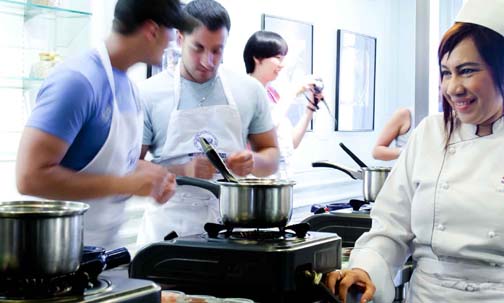

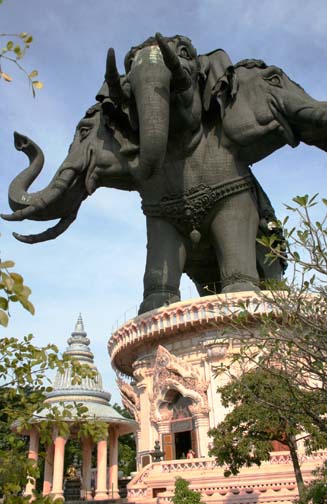
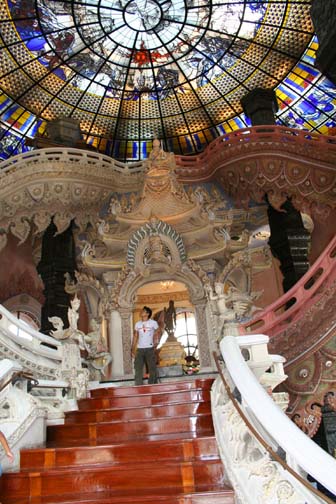

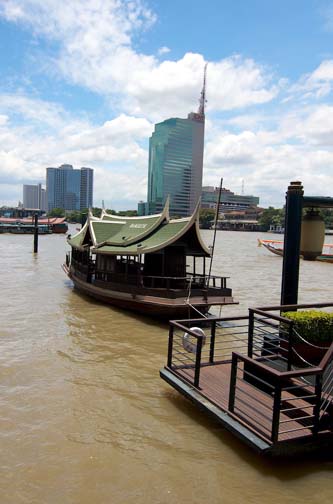
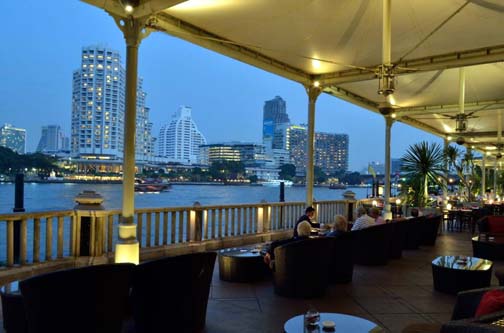
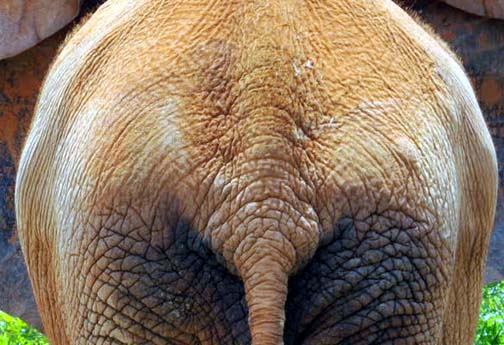
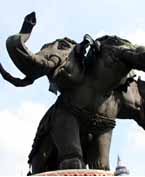


What elephant.? I don’t see an elephant.
Um, look for that thing too big to be a dick . . . what it’s attached to is an elephant.
I hope.
I could not get past the Bubble Butt in the foreground 🙂
Enjoyed the Erawan Museum and grounds after reading your previous recommendation. Netherworld was closed for a remodel, so we will have to return. Baipai cooking school offers classes at two locations in Bangkok and I think it is a little more laid back than the Elephant. I liked learning the various Thai ingredients and cooking techniques. The Oriental offers a nice Thai luncheon buffet via shuttle boat in their spa complex across the river. The luncheon is an affordable luxury which I enjoy every visit. Bike tours are a fun option as well. The terrain is relatively flat and when your peddling you get a nice breeze. Ilbonito’s “Off the Grid” recommends the K tron Flying Chicken which I am going to try next time. K tron cooks your chicken and catapults it to the unicycling waiter who impales your bird on his spiked helmet while enroute to your table to deliver your dinner. So, I guess there is something for everyone.
I’ve heard about that chicken place but have yet to visit. Sounds more like it would be a fun experience rather than a place to actually eat. But it’s on my list!
I’d forgotten about the spa across the river at the Oriental – Ann always demanded we indulge when we stayed there and I always whined about having to take a damn boat just to get a massage. But the luncheon part I didn’t know about, or forgot about, and that sounds like it would make for a nice afternoon. Noom will be in heaven both for dining at a hi-so place and being able to laugh at the prices so I think we’ll try that one on my next visit.
Thanks Bear! I love getting useful recommendations to help keep my visits fresh, fun, and exciting!
Bangkok “relatively flat” – gee, really? Sounds like something Beachbore googled rather than being written by someone who knows Bangkok. I’m going to go out on a limb here & speculate it’s flat because it is built on a river delta. I do wonder if it ever floods there with an average elevation of 1.5 meters.
The hotel changed it’s name to “Mandarin Oriental, Bangkok” almost five years ago. The exterior of the historic wing of the hotel still has “Oriental Hotel” lettering preserved, while the newest wing has “Mandarin Oriental” signage. I’m sure you’ve been staying there since 19-ought-something and the old name just slips out. 😉
The Sala Rim Naam dinner show across the river is decent and perhaps worth the price for a new visitor, but too big and crowded to get my recommendation. The Authors’ Lounge afternoon tea is definitely worth the expense even for returning tourists.
That was it! When Le Bear mentioned the luncheon I vaguely remembered a restaurant across the river . . . it was that dinner show. Not that I ever went. The touri luau scene in Hawaii kinda taught me better.
The luncheon is in the same restaurant, but there is no show. I did not know the name, but the googled images for Sala Rim Naam show the same restaurant. I know it is not open for lunch every day, so it is best to call ahead. I think last time it was open for lunch on the weekends. I passed through the Authors’ Lounge, but that is not my cup of tea. The Oriental is nice for a visit, but I prefer to stay at a 4 star.
I like the Oriental as a treat for my last night or two in town. I’ve never not felt comfortable there, but I prefer a place that’s a little bit more laid back. And as cool as having their own dock is, it’s a bit far from the BTS so transpo options suck. But I will try Sala Rim Naam for lunch – hope it is not just on weekends though, there’s so many good places to eat then it’s difficult at times to pick one.
The view is not out of the elephant’s ass, but out of a minuscule window on the side of his body. And due to its small size and it being located at the lower part of the body, the view is hardly worth writing about.
But is if you decide that window is in the elephant’s ass.